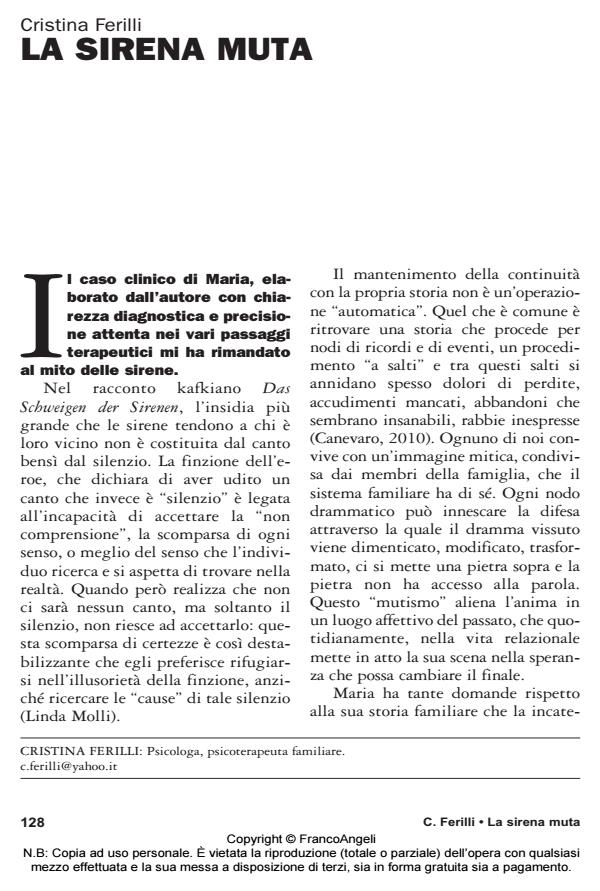The mute mermaid
Journal title PSICOBIETTIVO
Author/s Cristina Ferilli
Publishing Year 2015 Issue 2015/1 Language Italian
Pages 6 P. 128-133 File size 96 KB
DOI 10.3280/PSOB2015-001009
DOI is like a bar code for intellectual property: to have more infomation
click here
Below, you can see the article first page
If you want to buy this article in PDF format, you can do it, following the instructions to buy download credits

FrancoAngeli is member of Publishers International Linking Association, Inc (PILA), a not-for-profit association which run the CrossRef service enabling links to and from online scholarly content.
This work is a review of Maria’s clinical case made using a systemic-relational perspective. The Kafka tale Das Shweingen der Sirenen is used as a metaphor for human suffering amplified by loneliness of what you live and the impossibility of sharing the meaning of what traumatic happened. Maintaining continuity with its own history is not an "automatic". What is common is finding a story that proceeds by knots of memories and events, a process "jumps" and between these jumps lurk often pain of loss, the acts of caring missed, abandonments that seem irreconcilable, unexpressed anger. The therapeutic art sews the significance of the drama lived. Special care has been given on the definition of the trigeneration frame, especially important with people with past so sad and painful; family history; welcome on the frustrations of relational patient and then promote the relevant competences; the importance of the use of analogic language therapy to explore the mythic dimensions and of floating objects, namely "masks". The work ends with a return greeting Mary: the metaphoric tale.
Keywords: Systemic Psychotherapy; Trigeneration Frame; Family History; Myth, Analogic Language; Floating Objects; Metaphoric Tale.
- Bowen M. (1979) Dalla famiglia all’individuo, Astrolabio, Roma
- Caillé P., Rey Y. (2005) Gli oggetti fluttuanti-metodi di interviste sistemiche,
- Armando, Roma
- Canevaro A. (2010) Quando volano i Cormorani. Terapia individuale sistemica con il coinvolgimento dei familiari significativi, Borla, Roma
- Cigoli V. (1997) Intrecci familiari, Raffaello Cortina, Milano
- Cyrulnik B. (2009) Autobiografia di uno spaventapasseri. Strategie per superare le esperienze traumatiche. Raffaello Cortina, Milano
- Kafka F. (1988) Lettere, Mondadori, Milano
- Kafka F. (1994) Il silenzio delle sirene. Scritti e frammenti postumi (1917-1921), Introduzione di Gustaw Herling, traduzione a cura di Andreina Lavagetto, Feltrinelli, Milano
- Molli L. Un viaggio tra inquietudine e seduzione: la ripresa del mito delle Sirene nella letteratura contemporanea, www.Academia.edu
- Onnis L. (1996) “La narrazione analogica: l’uso del linguaggio metaforico nella terapia sistemica”, Psicobiettivo, vol. 16, 3: 17-35
- Onnis L., Laurent M., Benedetti P., Cespa G., Di Gennaro A.,Dentale R.C., De Tiberis F., Forato F., Maurelli F. (1994) “Il mito familiare, concetti teorici e implicazioni terapeutiche”, Ecologia della mente, 17, 2: 95-114
Cristina Ferilli, La sirena muta in "PSICOBIETTIVO" 1/2015, pp 128-133, DOI: 10.3280/PSOB2015-001009